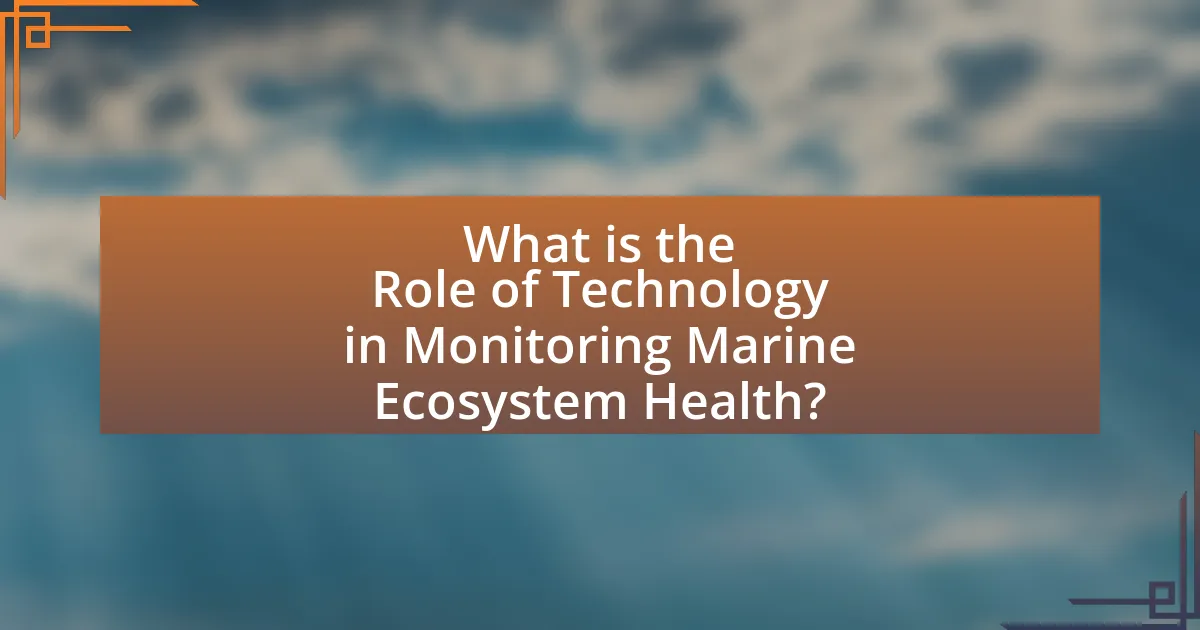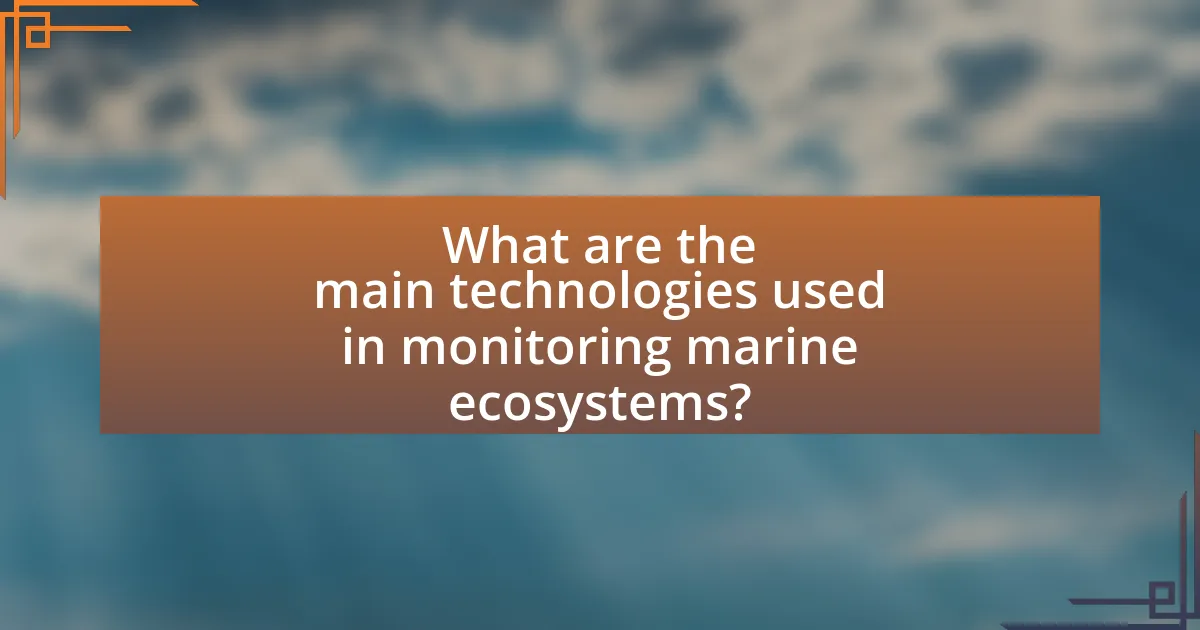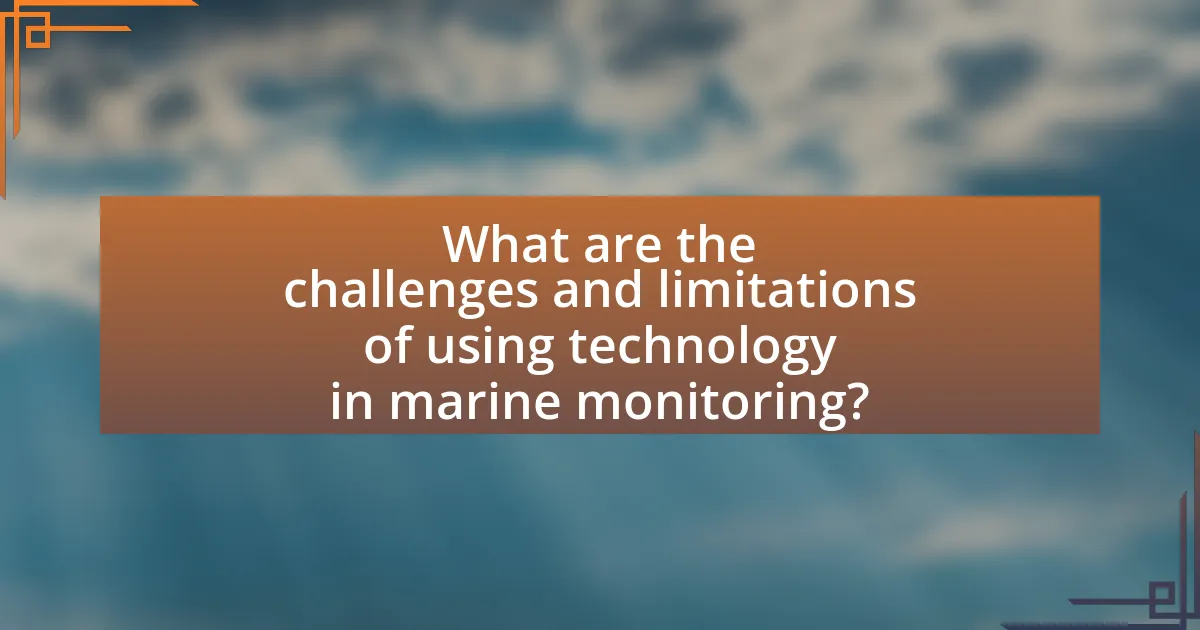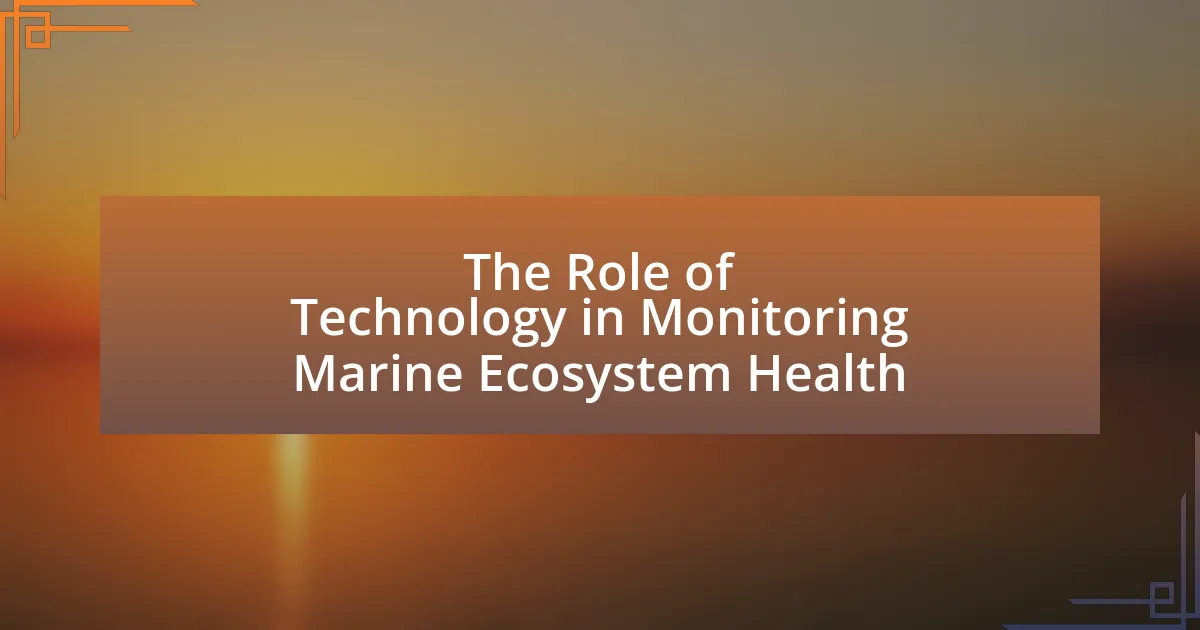The article focuses on the critical role of technology in monitoring marine ecosystem health. It highlights various advanced tools such as remote sensing, underwater drones, and autonomous monitoring systems that facilitate real-time data collection and analysis of water quality, biodiversity, and habitat conditions. Key indicators of marine health, including biodiversity and water quality, are discussed alongside the technologies used to assess them, such as satellite imagery and underwater sensors. The article also addresses the challenges and limitations of current monitoring technologies, emphasizing the importance of collaboration and best practices for effective and sustainable marine ecosystem monitoring.

What is the Role of Technology in Monitoring Marine Ecosystem Health?
Technology plays a crucial role in monitoring marine ecosystem health by providing tools for data collection, analysis, and visualization. Advanced technologies such as remote sensing, underwater drones, and autonomous monitoring systems enable scientists to gather real-time data on water quality, biodiversity, and habitat conditions. For instance, satellite imagery can track changes in ocean temperature and chlorophyll levels, while underwater sensors can measure parameters like pH and dissolved oxygen. These technologies enhance the ability to detect environmental changes and assess the impacts of human activities, such as pollution and climate change, on marine ecosystems. Studies have shown that integrating technology into marine monitoring efforts leads to more accurate assessments and informed decision-making, ultimately supporting conservation and management strategies.
How does technology contribute to assessing marine ecosystem health?
Technology significantly contributes to assessing marine ecosystem health by enabling real-time monitoring and data collection through advanced tools such as remote sensing, underwater drones, and data analytics. These technologies allow researchers to gather critical information on water quality, biodiversity, and habitat conditions efficiently. For instance, satellite imagery can track changes in ocean temperature and chlorophyll levels, which are indicators of ecosystem health. Additionally, autonomous underwater vehicles can collect data on fish populations and coral reef conditions, providing insights into the overall health of marine environments. The integration of these technologies enhances the accuracy and speed of assessments, facilitating timely interventions to protect marine ecosystems.
What types of technologies are used in marine monitoring?
Various technologies are used in marine monitoring, including satellite remote sensing, autonomous underwater vehicles (AUVs), buoys, and underwater sensors. Satellite remote sensing enables large-scale observation of ocean conditions, such as temperature and chlorophyll levels, providing critical data for ecosystem assessments. AUVs are equipped with advanced sensors to collect data on water quality and marine life at various depths, enhancing our understanding of underwater environments. Buoys equipped with meteorological and oceanographic sensors continuously monitor surface conditions, while underwater sensors measure parameters like salinity, pH, and dissolved oxygen, which are essential for assessing marine ecosystem health. These technologies collectively contribute to comprehensive marine monitoring efforts, ensuring informed decision-making for conservation and management.
How do these technologies collect data on marine ecosystems?
Technologies collect data on marine ecosystems through various methods such as remote sensing, underwater drones, and acoustic monitoring. Remote sensing utilizes satellites and aerial imagery to gather information on ocean temperature, chlorophyll levels, and surface currents, providing large-scale data on ecosystem health. Underwater drones, equipped with cameras and sensors, capture high-resolution images and collect water samples, allowing for detailed assessments of marine biodiversity and habitat conditions. Acoustic monitoring employs hydrophones to detect and analyze sounds produced by marine life, which helps in understanding species distribution and behavior. These methods collectively enhance the understanding of marine ecosystems and inform conservation efforts.
Why is monitoring marine ecosystem health important?
Monitoring marine ecosystem health is important because it helps assess the overall condition of marine environments, which are vital for biodiversity, fisheries, and climate regulation. Healthy marine ecosystems support a wide range of species and provide essential services such as carbon sequestration and nutrient cycling. Research indicates that over 30% of marine species are threatened due to human activities, making monitoring crucial for conservation efforts and sustainable management. By tracking changes in water quality, species populations, and habitat conditions, stakeholders can make informed decisions to protect marine resources and ensure ecosystem resilience.
What are the key indicators of marine ecosystem health?
Key indicators of marine ecosystem health include biodiversity, water quality, and the presence of key species. Biodiversity reflects the variety of life forms in an ecosystem, with higher diversity indicating a healthier environment. Water quality is assessed through parameters such as nutrient levels, pH, and the presence of pollutants; for instance, excessive nutrients can lead to harmful algal blooms, which disrupt marine life. The presence of key species, such as apex predators and keystone species, indicates ecosystem stability and resilience. Studies have shown that ecosystems with diverse species and good water quality are more resilient to environmental changes, supporting the notion that these indicators are crucial for assessing marine health.
How does marine ecosystem health impact biodiversity?
Marine ecosystem health directly influences biodiversity by maintaining the balance of species and habitats. Healthy marine ecosystems, characterized by clean water, stable temperatures, and diverse habitats, support a wide variety of marine life, including fish, invertebrates, and plants. For instance, coral reefs, which thrive in healthy marine environments, are home to approximately 25% of all marine species despite covering less than 1% of the ocean floor. Conversely, degraded ecosystems, such as those affected by pollution or climate change, lead to habitat loss and species decline, resulting in reduced biodiversity. Studies have shown that areas with high marine biodiversity are often more resilient to environmental changes, underscoring the critical link between ecosystem health and species variety.

What are the main technologies used in monitoring marine ecosystems?
The main technologies used in monitoring marine ecosystems include remote sensing, autonomous underwater vehicles (AUVs), and environmental DNA (eDNA) analysis. Remote sensing utilizes satellite and aerial imagery to assess large-scale oceanographic conditions, such as temperature and chlorophyll concentrations, providing critical data for ecosystem health assessments. AUVs are equipped with sensors to collect data on water quality, biodiversity, and habitat structure at various depths, enabling detailed exploration of marine environments. eDNA analysis allows for the detection of species presence through genetic material collected from water samples, offering insights into biodiversity and ecosystem changes. These technologies collectively enhance our understanding of marine ecosystems and inform conservation efforts.
How do satellite technologies aid in marine monitoring?
Satellite technologies aid in marine monitoring by providing real-time data on ocean conditions, including temperature, chlorophyll levels, and sea surface height. These technologies utilize remote sensing to capture large-scale environmental changes, enabling scientists to track phenomena such as algal blooms, ocean currents, and the impacts of climate change. For instance, NASA’s MODIS (Moderate Resolution Imaging Spectroradiometer) satellite collects data that helps in assessing water quality and detecting harmful algal blooms, which can affect marine life and human health. Additionally, satellite altimetry measures sea level rise, contributing to understanding the effects of global warming on marine ecosystems.
What data can satellites provide about marine environments?
Satellites can provide critical data about marine environments, including sea surface temperature, chlorophyll concentration, ocean color, and sea level rise. These data points are essential for monitoring ecosystem health, as they help scientists assess the impacts of climate change, track harmful algal blooms, and understand marine biodiversity. For instance, NASA’s MODIS (Moderate Resolution Imaging Spectroradiometer) satellite measures chlorophyll levels, which indicate phytoplankton health, a key component of the marine food web. Additionally, satellite altimetry data allows for precise measurements of sea level changes, which are crucial for understanding the effects of global warming on coastal ecosystems.
How has satellite technology evolved for marine monitoring?
Satellite technology has significantly evolved for marine monitoring through advancements in sensor capabilities, data processing, and accessibility. Initially, satellites provided basic imagery, but modern satellites now utilize high-resolution sensors that can capture detailed information on sea surface temperatures, chlorophyll concentrations, and ocean currents. For example, the European Space Agency’s Sentinel-3 satellite, launched in 2016, offers enhanced ocean color data and sea surface height measurements, improving the accuracy of marine ecosystem assessments. Additionally, the integration of artificial intelligence and machine learning has enabled more efficient data analysis, allowing for real-time monitoring and quicker response to environmental changes. This evolution has been crucial for tracking climate change impacts, managing fisheries, and protecting marine biodiversity.
What role do underwater sensors play in ecosystem monitoring?
Underwater sensors play a crucial role in ecosystem monitoring by providing real-time data on various environmental parameters such as temperature, salinity, and dissolved oxygen levels. These sensors enable researchers to track changes in marine ecosystems, assess biodiversity, and monitor the health of aquatic habitats. For instance, studies have shown that underwater sensors can detect shifts in water quality that may indicate harmful algal blooms or the impacts of climate change, allowing for timely interventions. The integration of these sensors into monitoring programs enhances the ability to collect accurate and continuous data, which is essential for effective management and conservation of marine resources.
What types of underwater sensors are commonly used?
Commonly used underwater sensors include acoustic sensors, optical sensors, and chemical sensors. Acoustic sensors, such as sonar devices, are utilized for mapping underwater topography and detecting marine life. Optical sensors measure light levels and can assess water clarity and phytoplankton concentrations. Chemical sensors analyze water quality by detecting parameters like pH, dissolved oxygen, and nutrient levels. These sensors are essential for monitoring marine ecosystem health, as they provide critical data for understanding environmental changes and assessing the impacts of human activities on aquatic habitats.
How do underwater sensors enhance data accuracy?
Underwater sensors enhance data accuracy by providing real-time, high-resolution measurements of various environmental parameters such as temperature, salinity, and pressure. These sensors are designed to operate in challenging underwater conditions, minimizing human error and ensuring consistent data collection. For instance, studies have shown that autonomous underwater vehicles equipped with advanced sensors can collect data with an accuracy of up to 95%, significantly improving the reliability of marine ecosystem assessments. This precision is crucial for monitoring changes in marine health, as it allows researchers to detect subtle shifts in environmental conditions that may indicate larger ecological trends.

What are the challenges and limitations of using technology in marine monitoring?
The challenges and limitations of using technology in marine monitoring include high costs, data accuracy issues, and environmental factors affecting sensor performance. High costs can limit access to advanced monitoring technologies, making it difficult for smaller organizations to implement effective monitoring systems. Data accuracy issues arise from sensor calibration and the potential for human error in data interpretation, which can lead to misleading conclusions about marine ecosystem health. Environmental factors, such as extreme weather conditions and underwater currents, can disrupt sensor functionality and data transmission, further complicating monitoring efforts. These challenges highlight the need for ongoing research and development to enhance the reliability and affordability of marine monitoring technologies.
What technical challenges do researchers face in marine monitoring?
Researchers face several technical challenges in marine monitoring, including data collection limitations, sensor reliability, and data integration issues. Data collection is hindered by the harsh marine environment, which can damage equipment and lead to gaps in data. Sensor reliability is critical, as instruments must function accurately over extended periods in varying conditions, yet many sensors experience drift or failure. Additionally, integrating diverse data types from multiple sources, such as satellite imagery, underwater sensors, and biological surveys, poses significant challenges in achieving a comprehensive understanding of marine ecosystems. These challenges are well-documented in studies highlighting the need for improved technology and methodologies in marine research.
How do environmental factors affect technology performance?
Environmental factors significantly influence technology performance by affecting the reliability, efficiency, and accuracy of devices used in monitoring marine ecosystems. For instance, temperature fluctuations can impact sensor calibration, leading to erroneous data readings. Humidity levels can cause corrosion in electronic components, reducing the lifespan and functionality of monitoring equipment. Additionally, water salinity can interfere with signal transmission in underwater communication systems, affecting data transfer rates. Studies have shown that extreme weather conditions, such as storms or high waves, can disrupt the operation of marine monitoring technologies, leading to data loss or equipment failure. Therefore, understanding and mitigating the effects of environmental factors is crucial for optimizing technology performance in marine ecosystem monitoring.
What are the limitations of current monitoring technologies?
Current monitoring technologies face several limitations, including high costs, limited spatial and temporal resolution, and challenges in data integration. High costs restrict widespread adoption, particularly in developing regions, where budget constraints hinder the implementation of advanced monitoring systems. Limited spatial and temporal resolution can result in insufficient data to accurately assess marine ecosystem health, as many technologies may not capture rapid changes or cover extensive areas effectively. Additionally, challenges in data integration arise from the use of diverse technologies and methodologies, making it difficult to synthesize information into a coherent understanding of ecosystem dynamics. These limitations hinder the effectiveness of monitoring efforts and the ability to make informed management decisions.
How can these challenges be addressed?
Challenges in monitoring marine ecosystem health can be addressed through the implementation of advanced technologies such as remote sensing, autonomous underwater vehicles (AUVs), and data analytics. Remote sensing allows for the collection of large-scale environmental data, enabling real-time monitoring of water quality and habitat changes. AUVs facilitate in-depth exploration of underwater ecosystems, providing valuable insights into species distribution and health. Data analytics, including machine learning algorithms, can process vast amounts of data to identify trends and predict ecosystem responses to environmental stressors. These technologies have been validated in various studies, such as the use of satellite imagery to track algal blooms, demonstrating their effectiveness in enhancing marine monitoring efforts.
What innovations are being developed to improve marine monitoring?
Innovations being developed to improve marine monitoring include the use of autonomous underwater vehicles (AUVs), satellite remote sensing, and advanced sensor technologies. AUVs enable detailed mapping and data collection in hard-to-reach areas, enhancing the understanding of marine ecosystems. Satellite remote sensing provides large-scale monitoring of ocean conditions, such as temperature and chlorophyll levels, facilitating real-time data analysis. Advanced sensor technologies, including environmental DNA (eDNA) sampling, allow for the detection of species presence and biodiversity assessment without the need for physical samples. These innovations collectively enhance the accuracy and efficiency of marine monitoring efforts, supporting better management of marine resources.
How can collaboration enhance technology effectiveness in marine ecosystems?
Collaboration can enhance technology effectiveness in marine ecosystems by facilitating the sharing of data, resources, and expertise among various stakeholders, including researchers, government agencies, and local communities. This collective effort leads to the development of more comprehensive monitoring systems that can accurately assess ecosystem health. For instance, initiatives like the Global Ocean Observing System (GOOS) demonstrate how collaborative frameworks enable the integration of diverse data sources, improving the reliability of oceanographic data. Furthermore, partnerships can drive innovation in technology, as seen in projects that combine satellite imagery with local knowledge to monitor changes in marine habitats, thus ensuring more effective conservation strategies.
What best practices should be followed for effective marine ecosystem monitoring?
Effective marine ecosystem monitoring requires the implementation of standardized protocols, integration of advanced technologies, and continuous data analysis. Standardized protocols ensure consistency in data collection, allowing for reliable comparisons over time and across different regions. Advanced technologies, such as remote sensing, underwater drones, and autonomous sensors, enhance the ability to gather real-time data on various ecological parameters, including water quality, biodiversity, and habitat conditions. Continuous data analysis facilitates timely decision-making and adaptive management strategies, ensuring that monitoring efforts are responsive to changing environmental conditions. These practices are supported by research indicating that systematic monitoring frameworks improve the understanding of marine ecosystem dynamics and inform conservation efforts.
How can data from technology be effectively analyzed and utilized?
Data from technology can be effectively analyzed and utilized by employing advanced analytical tools and methodologies such as machine learning, data visualization, and statistical analysis. These techniques enable researchers to process large datasets generated by sensors and monitoring devices in marine ecosystems, allowing for the identification of patterns and trends that inform ecosystem health assessments. For instance, machine learning algorithms can classify species and predict changes in biodiversity based on environmental variables, while data visualization tools can present complex information in an accessible format, facilitating decision-making for conservation efforts. Studies have shown that integrating these analytical approaches leads to more accurate monitoring and management of marine ecosystems, as evidenced by projects that successfully utilized satellite data to track ocean temperature changes and their impact on marine life.
What strategies can be implemented to ensure sustainable monitoring practices?
To ensure sustainable monitoring practices, the implementation of integrated technology solutions is essential. Utilizing remote sensing technologies, such as satellite imagery and drones, allows for real-time data collection on marine ecosystems, reducing the need for invasive sampling methods. For instance, a study by the National Oceanic and Atmospheric Administration (NOAA) highlights that satellite data can monitor ocean temperatures and chlorophyll levels, providing critical insights into ecosystem health without physical disruption. Additionally, employing data analytics and machine learning can enhance the interpretation of collected data, enabling more efficient resource allocation and timely decision-making. These strategies collectively promote sustainability by minimizing environmental impact while maximizing the effectiveness of monitoring efforts.
